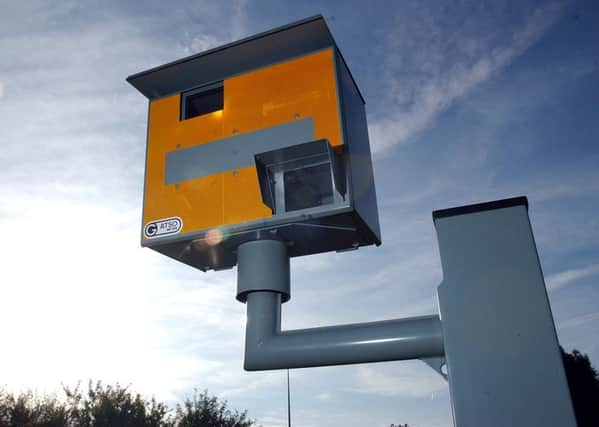One in three Lancashire speed cameras don’t work


Across the county there are 43 cameras but police admit 16 of them are “mothballed due to faults”.
At 37%, it’s significantly higher than the national average of 23% out of order and the findings, from a Freedom of Information request by our sister newspaper the Lancashire Evening Post, come at a time when overall speeding offences in Lancashire are up 14%.
Advertisement
Hide AdAdvertisement
Hide AdRoad safety campaigners are now worried the cost of replacing cameras – up to £20,000 a time – could prevent the use of the deterrant, aimed at saving lives and preventing injuries.
Lancashire Constabulary insists it is committed to using the cameras, and although bosses admit there have been “some delays” in the procurement of appropriate digital upgrades to the fixed sites, say this has been resolved.
A police spokesman said: “Some of the older wet film cameras are no longer in use due to the high costs involved in repairing them and plans to digitise the units in the near future. It is anticipated that parts from these units will be utilised during the digital upgrade to reduce costs.”
Lancashire Constabulary also uses nine hand-held speed cameras, which in 2014 caught 51% more speeding motorists in the county compared to fixed cameras, at 38,243 cases compared to 19,600.
Advertisement
Hide AdAdvertisement
Hide AdBetween the two types of camera, there were 57,843 offences last year, up from 49,573 in 2013.
Lancashire Constabulary said static cameras are not being phased out in favour of mobile equipment, a spokesman adding: “There is very little difference in the number of offences recorded by the static cameras, in fact they are slightly lower.
“The increase in detections from mobile units is most likely due to a change in tasking following the rollout of Lancashire Road Watch around the county where additional sites were introduced, along with the ability to respond to local concerns in relation to excess speed through speed tasking meetings which are attended by representatives from local authorities and the police.”
Steve Gooding, director of the RAC Foundation, said: “A significant majority of the public back the use of speed cameras to improve road safety and our research suggests they can be effective as part of a wider strategy.
Advertisement
Hide AdAdvertisement
Hide Ad“Three years ago English councils warned us the cost of replacing obsolete equipment could be unaffordable with digital cameras costs as much as £20,000 a time.
“The bottom line is that money should be spent on those initiatives where most lives are saved, the real question is whether replacing cameras is still the best answer for tackling inappropriate speed at these locations.”
Philip Goose, senior community engagement officer at Brake, the road safety charity, said: “Speed cameras are cost-effective. Installation, maintenance, and administration can be self-funded by fines, if this money is ring-fenced to re-invest into road safety measures.
“Cameras will also pay for themselves several time over through the money saved to the economy by preventing deaths and serious injuries: road crashes were estimated to cost the economy £14.7 billion in 2013 due to human costs and costs to emergency, health and criminal justice services.
Advertisement
Hide AdAdvertisement
Hide Ad“Cameras can catch far higher number of speeding drivers than traffic police with mobile cameras, and at much lower cost, freeing up police for other duties that cannot be conducted by technology, such as breath-testing.”
Kevin Clinton, head of road safety at the Royal Society for the Prevention of Accidents (RoSPA), said: “Speed cameras are a very effective way of reducing speeds and preventing accidents, especially in preventing more serious and fatal accidents. We believe that cameras should be used where casualty statistics show they are needed as they can help to save lives and prevent injuries.”
He added: “Cameras are, of course, only one of the ways of making our roads safer, and they work in conjunction with the many other safety measures we use, such as traffic calming, 20 mph zones and limits, and road safety education and training.”
The research, by price comparison site Confused.com comes on the 23rd anniversary of the first speed camera being introduced on a UK road.
Advertisement
Hide AdAdvertisement
Hide AdIt also shows that while two thirds of drivers (66%) admit to speeding, less than a third (31%) say they have actually been caught speeding.
Gemma Stanbury, head of Motor at Confused.com, said: “It has been 23 years since the very first speed camera was introduced on British roads and they remain as divisive a subject as ever. And while many might point to the fact that nearly a quarter (23%) of fixed speed cameras aren’t in use, people should be keeping to speed limits regardless of whether cameras are there or not.
“A speeding fine can have repercussions, from a fine and points on your licence to a driving ban, not to mention increased insurance premiums. It’s a drivers’ responsibility to tell their insurer whether they have any convictions. Failure to do so could lead to a policy being invalid or the increased premium being backdated.”